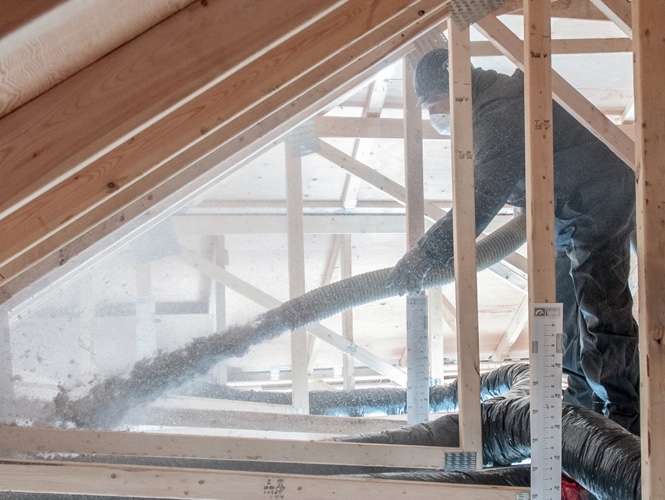- +514 694 1485
- igloo@cellulose.com
- 2999 Avenue Miller, Dorval, QC H9P 0A1, Canada
Why choose Igloo cellulose insulation? What are the advantages and disadvantages of this biobased insulation compared to mineral insulation? Which buildings can be insulated with Igloo cellulose? What parts of a building can be insulated with cellulose? How is it installed? All the information you need about insulating with Igloo cellulose is in this comprehensive guide!
Quick access :
Igloo cellulose is a biosourced loose-fill insulation used to insulate the inside of buildings. It is a high-performance thermal insulator that combats extreme temperature variations, providing comfort in both hot and cold weather.
Thanks to its technical performance, Igloo cellulose has a significantly longer phase shift than mineral insulation.
Made from 85% selected fibres from recycled paper, Igloo cellulose can be blown into attics or injected at high density into walls, ceilings and floors. Igloo cellulose can also be stabilised on sloping ceilings by adding water at the time of blowing.




Cellulose has been used for over a century to insulate buildings. Its thermal performance is widely recognised, providing comfort in both winter and summer.
Igloo cellulose has a phase-shifting capacity almost 3 times greater than mineral wools, as well as superior resistance to weather and temperature variations. By insulating the attics and walls of your home with cellulose, the temperature inside will be more stable and less affected by outside temperature variations.
Whether you live in the city or the country, in a detached house or a condo, you are not immune to noise. Noise pollution can make your home a living hell.
Igloo cellulose is the solution to noise pollution and greatly improves your quality of life:
Igloo cellulose has natural characteristics that make it an excellent acoustic (or phonic) insulator:


Igloo cellulose has hygroscopic properties that help it to regulate humidity and prevent the growth of mould.
Like a sponge, cellulose absorbs excess moisture, retaining it and releasing it when the atmosphere becomes drier.
Cellulose can absorb up to 15% of its weight in water without losing its thermal and acoustic performance.
Igloo cellulose is made from 85% of various selected sources from the paper industry, collected through recycling channels.
It is manufactured by simple mechanical shredding, without the need for water or combustion. It therefore consumes very little energy.
Igloo cellulose contains no ammonium sulphate, is non-irritating and free of VOC emissions, and has been awarded Greenguard certification.
It is eligible for use in LEED-certified and low-VOC emission buildings. It is particularly recommended for Passivhaus projects and Net Zero constructions.
Igloo cellulose is therefore an eco-friendly biosourced insulation.


Its loose form means it can be adapted to any thickness and size of wall to be insulated. A single product for all applications.

Igloo cellulose can achieve a higher density than mineral wool insulation, making it more resistant to airflow.

Cellulose is made from selected fibres recycled by the paper industry. At the end of its life, cellulose can also be recycled.

During the manufacture of Igloo cellulose, we add salts to improve its reaction to fire. Igloo cellulose protects the structure for longer in the event of a fire.

Cellulose is not conducive to vermin and rodents, thanks to the use and effectiveness of boron salt as a natural repellent.

When correctly installed, cellulose has a lifespan of around 75 years or more, with no loss or reduction in its thermal and acoustic performance.

We support professionals (architects, general contractors) in preparing and drawing up technical specifications.

We support installers with training and installation of Igloo cellulose.
Thanks to its loose form, Igloo cellulose can be applied to the entire interior envelope of a building.

Cellulose is suitable for renovating, updating to thermal standards, but also for the new construction of all types of buildings.

Cellulose injected at high density into the interior walls of a building provides complete, optimum insulation without heat loss. Thanks to the acoustic properties of cellulose, it also provides greater soundproofing comfort. This technique must be carried out by a qualified and certified installer in order to comply with installation rules and avoid subsidence.

In residential buildings such as multi-unit dwellings, cellulose is injected at high density into ceilings and intermediate floors. This ceiling sound insulation reduces noise between flats.
FOR HOMEOWNERS
Are you a homeowner looking for the contact details of an Igloo installer near you?
FOR INSTALLERS
Are you an installer who would like to know the price of Igloo cellulose for your project?
FOR PROFESSIONALS
Are you a professional looking for a technical quote for one of your projects?
Igloo cellulose is suitable for renovating insulation in buildings: attics, ceilings, walls and floors.
In winter, heat loss can have harmful consequences for buildings, such as ice formation, mould, premature deterioration of the roof and condensation. Condensation forms when there is heat loss or a lack of ventilation.
In summer, on the other hand, a lack of ventilation in the attic causes major problems. The outside temperature can reach over 40°C, so it’s vital to slow the entry of this heat into buildings to maintain a comfortable temperature.
With biosourced insulation such as Igloo cellulose, the heat is kept outside for longer thanks to its phase-shifting capacity: for an attic insulated with blown cellulose with a thermal resistance of R = 40, it will take 9? hours for the heat to enter the building, compared with 3? hours for blown mineral wool with the same thermal resistance.
When renovating attic insulation, it is essential to comply with the regulations. A technical inspection is compulsory before the work is submitted.
Igloo Cellulose trains its partners in these regulations, to ensure that the work is carried out safely and in accordance with the rules of the trade.

Igloo cellulose is suitable for insulating all types of building: residential, agricultural, office and industrial. It can be installed in attics, where it is blown in, and in intermediate ceilings/floors and walls, where it is injected at high density.

Cellulose is a biosourced insulator with hygroscopic properties. Like a sponge, cellulose absorbs excess moisture from the atmosphere, stores it and releases it when the atmosphere becomes drier. In this way, it helps to maintain a comfortable level of humidity, and you feel more comfortable inside the building. Installed in agricultural buildings, it is not conducive to the growth of mould.
This thermal insulation is resistant to vermin (rodents and insects) thanks to its densely entangled fibres. Cellulose is ideal for industrial, agricultural and residential buildings, from walls to attics.
This material is also particularly favoured in residential buildings such as multi-dwellings (condos), because its acoustic properties guarantee better sound insulation between floors.
High-density injection moulding provides effective insulation for ceilings, intermediate floors and walls in buildings.
Igloo Cellulose trains its installers in these regulations, to ensure that the work is carried out safely and to the highest standards.
Please do not hesitate to contact us if you would like any further information about our products and/or services.